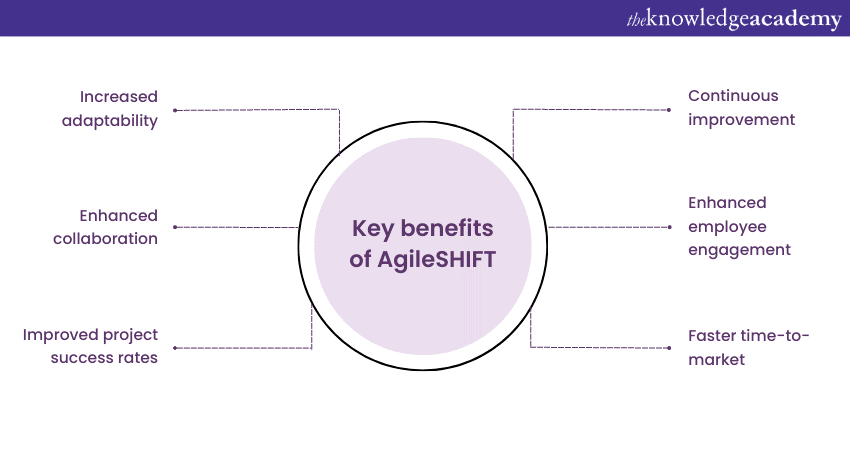We may not have the course you’re looking for. If you enquire or give us a call on + 800 908601 and speak to our training experts, we may still be able to help with your training requirements.
Training Outcomes Within Your Budget!
We ensure quality, budget-alignment, and timely delivery by our expert instructors.

Traditional project management methodologies have served well for many organisations. Still, organisations using these methods often struggle to keep up with the dynamic nature of the modern workplace. This is where AgileSHIFT comes in and transforms the traditional ways of organisation and management.
AgileSHIFT is a revolutionary framework that helps organisations embrace agility and navigate the complexities of change. In this blog, you will learn what is AgileSHIFT, how it transforms traditional project management, and how organisations can benefit from adopting it.
Table of Contents
1) What is AgileSHIFT?
a) Who is it for?
2) How does the AgileSHIFT work?
3) Benefits of adopting AgileSHIFT
4) Conclusion
What is AgileSHIFT?
AgileSHIFT is a transformative approach to change management developed by AXELOS, the same organisation responsible for frameworks like ITIL and PRINCE2. However, it is designed to help organisations navigate the complexities of change and embrace agility at an enterprise level, not just at the level of IT and projects. Unlike traditional project management methodologies, it focuses on creating a culture of collaboration, adaptability, and continuous improvement.
To be AgileSHIFT means to adopt a mindset and set of practices that enable organisations to thrive in an ever-changing business environment. It goes beyond implementing Agile practices in individual projects and extends to the entire organisation. It emphasises the importance of flexibility, responsiveness, and delivering value to customers.
It offers a structured framework that guides organisations through the change process. It provides a holistic view of Agile practices and principles, enabling a common understanding and language across the organisation. By adopting AgileSHIFT, organisations can transform their project management practices, improve collaboration, and effectively respond to market demands.

Who is it for?
Many organisations that want to incorporate Agile often run into problems because Agile delivery teams get isolated. This is often due to the lack of support from the overall organisation. Teams like Finance, HR, Operations, Sales & Marketing function with the traditional approach and do not understand why Agile working processes are used or how it benefits them.
This is why AgileSHIFT has been designed for the overall organisation and is apt for any team regardless of role or function. It applies to any organisation that recognises the need to embrace agility and adapt to change and stay competitive in an ever-changing market.
Make your teams understand the importance of Agile and how it can help them work better with Agile for Teams training.
How does AgileSHIFT work?
AgileSHIFT operates on the fundamental principles of empowering people, fostering collaboration, and embracing continuous improvement. It provides a structured framework and a set of practices to guide organisations through the change process. Here's how AgileSHIFT works.
AgileSHIFT framework
At the core of AgileSHIFT is its comprehensive framework, which provides a holistic view of Agile practices and principles. The framework is a common reference and language for everyone involved in the change journey, ensuring a shared understanding of Agile concepts and approaches.
Roles and responsibilities
AgileSHIFT defines clear roles and responsibilities for individuals involved in the change process. It establishes the AgileSHIFT team, consisting of a Shift Leader, Shift Coaches, and Shift Team Members. The Shift Leader acts as the change agent, guiding the organisation through the transformation. Shift Coaches support teams and individuals, facilitating the adoption of Agile practices. Shift Team Members are responsible for implementing the changes within their respective areas.
Value-driven delivery
AgileSHIFT emphasises delivering value early and continuously. It encourages organisations to define value propositions, identify customer needs, and prioritise work based on value. This value-driven approach ensures that projects and initiatives align with strategic objectives and deliver tangible outcomes to stakeholders.
Tailored approach
AgileSHIFT recognises that every organisation is unique, and one size does not fit all. It encourages a tailored approach to change management, allowing organisations to adapt the framework to their needs and context. It provides flexibility to incorporate existing methodologies and practices, enabling a smooth transition to an Agile way of working.
AgileSHIFT practices
AgileSHIFT introduces a range of practices that support adopting Agile ways of working. These practices include creating a compelling case for change, engaging stakeholders at all levels, fostering a learning culture, promoting transparency and communication, and encouraging experimentation and adaptation. These practices form the building blocks for successful change management within the AgileSHIFT framework.
Continuous improvement
AgileSHIFT emphasises the importance of continuous improvement throughout the change journey. It encourages organisations to reflect on their practices, learn from their experiences, and make iterative adjustments to improve performance and outcomes. This focus on continuous improvement ensures that organisations continuously evolve and adapt to changing circumstances.
Embrace Shift Left Testing! Start now for faster, high-quality releases. Get Agile!
Benefits of adopting AgileSHIFT
The adoption of AgileSHIFT brings numerous benefits to organisations. Let's explore some of the key benefits.

a) Increased adaptability: AgileSHIFT equips organisations to respond quickly to change, stay competitive, and seize new opportunities.
b) Enhanced collaboration: AgileSHIFT fosters a culture of teamwork, breaking down silos and promoting innovation through collaboration.
c) Improved project success rates: Its value-driven approach aligns projects with strategic goals, leading to higher success rates and customer satisfaction.
d) Faster time-to-market: Its iterative approach accelerates product/service delivery, allowing organisations to take advantage of market opportunities.
e) Enhanced employee engagement: AgileSHIFT empowers employees, increasing motivation, job satisfaction, and commitment to organisational goals.
f) Continuous improvement: It promotes a learning culture, driving ongoing improvement and enabling organisations to adapt and innovate.
Transform your approach to Agile! Take the AgileShift exam and become a certified Agile practitioner.
Conclusion
Now that you understand What is AgileSHIFT, you can adopt this methodology to gain improved adaptability, collaboration, project success rates, faster time-to-market, enhanced employee engagement, and a culture of continuous improvement. Since it is applicable organisation-wide and not exclusive to any specific department, you can encourage AgileSHIFT in your organisation and drive the successful transformation to a more Agile organisation.
Build Project Management proficiency with our Agile Project Management Foundation (AgilePM®) - start your Agile journey now!
Frequently Asked Questions
Upcoming Project Management Resources Batches & Dates
Date
 AgileSHIFT®
AgileSHIFT®
Thu 12th Dec 2024
Thu 30th Jan 2025
Thu 20th Mar 2025
Thu 8th May 2025
Thu 10th Jul 2025
Thu 11th Sep 2025
Thu 6th Nov 2025







 Top Rated Course
Top Rated Course


 If you wish to make any changes to your course, please
If you wish to make any changes to your course, please


